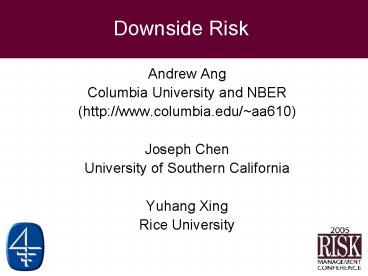Downside Risk
1 / 19
Title: Downside Risk
1
Downside Risk
- Andrew Ang
- Columbia University and NBER
- (http//www.columbia.edu/aa610)
- Joseph Chen
- University of Southern California
- Yuhang Xing
- Rice University
2
Motivation
- A fundamental tenet of Finance
- There is a trade-off between reward and risk
- But, how does one measure risk?
- According to the CAPM, risk is measured by beta,
or covariance with the market - But, the CAPM assumes an equal treatment of risk
across down markets and up markets
3
Downside vs Upside Risk
- Investors care differently about downside versus
upside risk - Markowitz (1959) advocates the use of
semi-variance as a risk measure - In loss aversion utility, investors place greater
weight on losses relative to gains - Investors more sensitive to downside risk require
a premium for holding assets with large exposure
to downside risk - Is there a downside risk premium in the cross-
- section of stock returns?
4
Aims and Goals
- Downside risk (downside beta)
- Covariation with the market conditional on
downside movements of the market - Distinguish downside risk from other
cross-sectional effects beta, size,
book-to-market, momentum, volatility, coskewness,
cokurtosis, liquidity - Downside premium of 6 per annum.
- Investigate if past downside beta predicts future
returns
5
Downside Beta
- CAPM Measure of Risk
- Beta, , is not a sufficient
statistic - Downside Beta
- Relative Downside Beta
6
A Risk Story
- Requirements for a risk story
- Need to observe patterns between average returns
and betas over the SAME PERIOD - Sort stocks on realized and investigate
relation to realized returns over the same
12-month period - Focus on equal-weighted portfolios of NYSE stocks
7
Sorts by b-
b-
8
Sorts by b-
Beta
9
Sorts by (b- - b)
b-
10
Sorts by (b- - b)
Beta
11
Fama-MacBeth Regressions
- Control for other known cross-sectional effects
- Size, Book-to-Market, and Momentum
- Volatility (Ang, Hodrick, Xing, Zhang, 2004)
- Coskewness (Harvey and Siddique, 2000)
- Cokurtosis (Dittmar, 2002)
- Liquidity risk (Pástor and Stambaugh, 2003).
12
Fama-MacBeth Regressions
- b 0.18
- b- 0.05 0.06
- b -0.03 0.02
- Log-Size -0.04 -0.03
- Book-to-Mkt 0.02 0.02
- Past Return 0.02 0.01
- Std Deviation -8.43 -6.46
- Coskewness -0.24 -0.19
- Cokurtosis 0.03 0.05
- Liquidity -0.01
13
Potential Bias?
- Is there a bias induced by computing b- and
average returns over the same period? - Measurement Error?
- Higher SE(b-) gt Attenuation to zero
- High betas are related to high average returns
by construction" - By conditioning on down moves of the market, we
pick up periods of low returns gt A priori expect
high b- to be associated with lower, not higher,
returns - b- is computed using demeaned market
- returns, which takes out any potential bias.
14
Robustness Checks
- Value-weighted portfolios and value-weighted
Fama-MacBeth regressions - Include all stocks (add AMEX/NASDAQ)
- Exclude small stocks
- Alternative cut-off points
- Relative to the risk-free rate
- Relative to a zero rate of return
- Use non-overlapping windows
- Use weekly 24-month returns to compute
- Control for coskewness
15
Forecasting Downside Risk
- Predicting Future Downside Risk and Future
Returns - There exists a strong contemporaneous relation
between downside risk and returns. - If we can predict future downside risk exposure,
we could form trading strategies to predict
future expected returns. - Which stocks have high downside risk?
- Is past downside beta persistent?
16
Determinants of Downside Risk
- Industry effects
- Utilities have lower b- loadings than other
industries - Stock characteristics
- Small and value stocks exhibit greater downside
risk - Past winner stocks have high downside risk
- Accounting measures of performance
- Stocks with high past ROE exhibit high downside
exposure - No leverage effect and little evidence that firms
paying dividends have less downside risk than
non-dividend payers - Contemporaneous risk measures
- High volatility, negative coskewness, and high
cokurtosis are related to high future downside
risk
17
Predicting Returns
- Future Returns with Past Downside Risk
- Removing Very High Volatility Stocks (Using 96
of All Stocks)
Average Excess Returns Per Month 1
Low 0.58 2 0.69 3 0.82 4 0.82 5
High 0.92 High-Low 0.34 T-stat 2.31
18
Predicting Returns
Characteristic-Adjusted Returns (per
month) Size/Bk-Mkt Include
Additional Controls for Adjusted Momentum Coske
wness Liquidity 1 Low b- -0.25 -0.21 -0.21
-0.17 2 -0.09 -0.07 -0.07 -0.02 3
0.05 0.04 0.07 0.05 4 0.07
0.10 0.04 0.10 5 High b- 0.20 0.12
0.15 0.13 High-Low 0.44 0.32 0.36
0.30 T-stat 3.36 2.71 2.69 2.15
19
Conclusion
- If investors are more risk averse to down
markets, then assets that have high exposure to
downside risk are unattractive and must command a
risk premium - The cross-section of stock returns reflects a
premium for downside beta risk - The downside premium is different from standard
beta and other known cross-sectional effects - Past downside beta can be used to forecast future
downside exposure, and hence future returns































